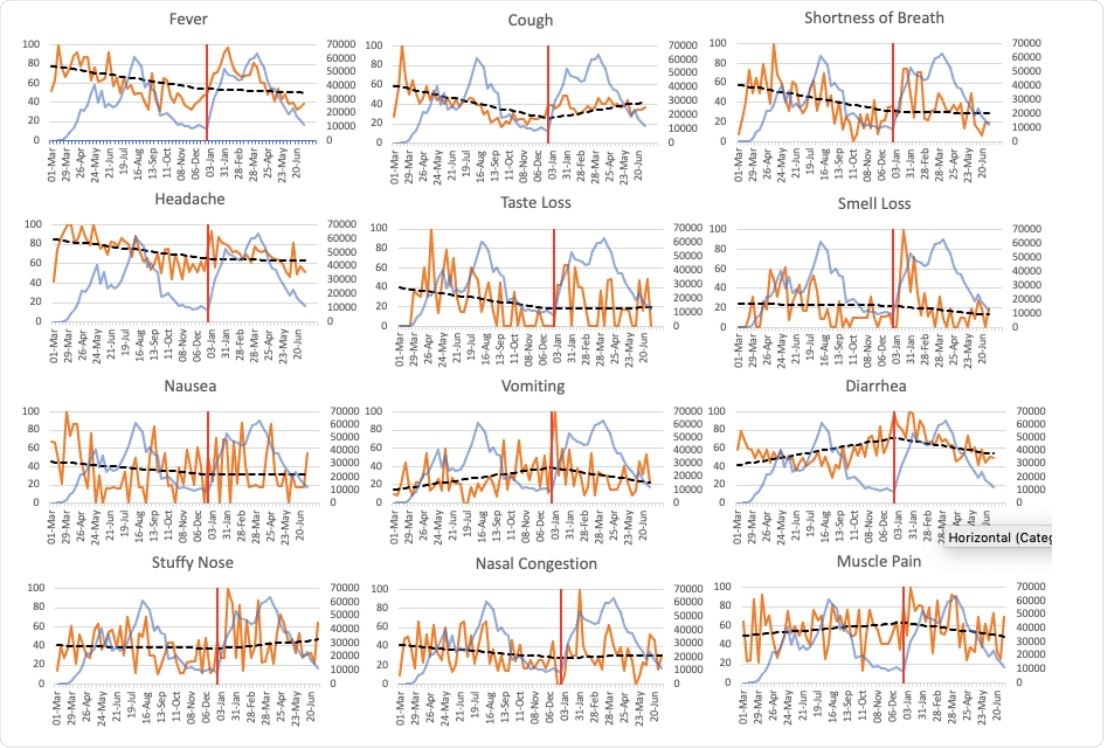The emergence of severe acute respiratory syndrome coronavirus 2 (SARS-CoV-2) variants has been a source of mounting concern to governments and public health authorities worldwide.
A new variant (lineage C.37) initially identified in Lima, Peru, has since been classified as “Lambda” by the World Health Organization (WHO). The lambda variant was classified in June 2021 by the WHO as a “variant of interest.”
Studies conducted on this variant suggest that it may have greater infectivity and can escape the body’s immune system, even when an individual has been fully vaccinated or has had the infection in the past.
With the dramatic rise of cases in Peru, from 0.5% of cases in December 2020, up to 96.6% in April 2021, the researchers utilized this as an opportunity to investigate infodemiologic trends in symptoms, testing, and other crucial parameters associated with the Coronavirus Disease 2019 (COVID-19) following the spread of SARS-CoV-2 Lambda variant in Peru.
Infodemiology is an area of scientific research focused on scanning the internet for user-contributed health-related content, with the ultimate goal of improving public health. In this study, the researchers focussed on Google web searches for specific keywords to predict regional epidemiological trends, symptoms and anticipating demand for specific diseases, especially in the case of novel pathogens. Such an analysis provides the real-world significance of trending search topics. In this case, the Google web searches focused on COVID-19 symptoms over time and SARS-CoV-2 testing.
A preprint version of the study, which is yet to undergo peer review, is available on the medRxiv* server.

 *Important notice: medRxiv publishes preliminary scientific reports that are not peer-reviewed and, therefore, should not be regarded as conclusive, guide clinical practice/health-related behavior, or treated as established information.
*Important notice: medRxiv publishes preliminary scientific reports that are not peer-reviewed and, therefore, should not be regarded as conclusive, guide clinical practice/health-related behavior, or treated as established information.
How was the internet used to trace symptoms for the Lambda Variant in Peru?
Researchers used Google Trends to gather all information. They obtained Weekly Google Trends scores for each symptom keyword between March 1st, 2020, and July 4th, 2021, within Peru, which has a population of approximately 31 million with Spanish as its official language.
The common keywords searched were ‘fever’, ‘cough’, ‘shortness of breath, ‘headache’, ‘smell loss’, ‘taste loss’, ‘fatigue’, ‘diarrhea’, ‘vomiting’, ‘nausea’, ‘nasal congestion’, ‘muscle pain’ and ‘stuffy nose’ in Spanish.
A single unit in Google Trends corresponds to the relative search interest per week based on a 100-point scale, where the maximum value correlates to the highest search volume for a particular term in the period studied. On the other hand, researchers obtained the weekly confirmed SARS-CoV-2 case counts in Peru from the Peruvian Health Ministry’s Open Data Repository.

Weekly SARS-CoV-2 cases in Peru and Google Trend Scores for specific symptom keywords for searches conducted within the country from March 1st, 2020, to July 4th, 2021.
What were the main observations?
The study period lasted from March 1st, 2020, to July 4, 2021. During this period, there was an alarming rise in the weekly SARS-CoV-2 cases; the numbers ranged from 8 in the week of March 1st, 2020, to 63,558 in the week of April 4th, 2021. A total of 1,013,930 cases were observed in the months before December 27th, 2020, and 1,061,554 cases after that following emergence of the Lambda variant. Two major peaks in cases were observed in Peru, a pre-Lambda peak the first in the week of August 16th, 2020, and a Lambda peak in the second week of April 4th, 2021.
During the study period, shortness of breath was the most consistent symptom associated with all the major variants circulating in the region. The Lambda variant introduced a new trend of diarrhea, which did not exist previously. No significant association was found with other gastrointestinal symptoms (i.e., nausea, vomiting) after the emergence of the Lambda variant.
The other known symptoms of the disease that were searched before the Lambda variant emerged were fever, cough, nasal congestion, fatigue, and muscle pain. These remained stable throughout. So did the key indicators of loss of taste and smell. This showed that there was no direct correlation between these general symptoms and specific variants, unlike in the pre-lambda wave where loss of taste and smell seemed to be the most prominent symptoms.
Importantly, headache showed a rather consistent tracing across the study period, with positive search correlations, similar to shortness of breath, to weekly case counts. This stressed the importance of headache in COVID-19 symptomatology.
What were the implications of this study?
This infodemiologic study shows that the SARS-CoV-2 Lambda variant in Peru is mainly marked by headaches, diarrhea, and shortness of breath. On the other hand, common cold symptoms appear to be less frequently associated with searches, indicating that they are not as much related specifically to the Lambda strain, and can vary among individuals.
The pattern of search terms studied through infodemiologic searches can thus provide valuable insights on some striking features relative to infections by specific strains, as more mutants of the novel coronavirus are studied. Infodemioolgy can be an important tool to trace symptoms of new variants, in the future.

 *Important notice: medRxiv publishes preliminary scientific reports that are not peer-reviewed and, therefore, should not be regarded as conclusive, guide clinical practice/health-related behavior, or treated as established information.
*Important notice: medRxiv publishes preliminary scientific reports that are not peer-reviewed and, therefore, should not be regarded as conclusive, guide clinical practice/health-related behavior, or treated as established information.
Journal reference:
- Preliminary scientific report.
Henry BM, Oliveira MHS de, Oliveira TB de, Notarte KI, Lippi G. Symptomatology associated with the diffusion of the SARS-CoV-2 Lambda variant in Peru: An infodemiologic analysis [Internet]. 2021 Aug [cited 2021 Sep 1] p. 2021.08.24.21262245. Available from: https://www.medrxiv.org/content/10.1101/2021.08.24.21262245v1